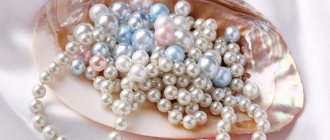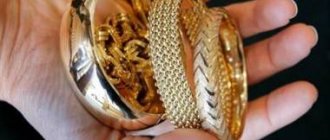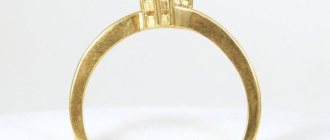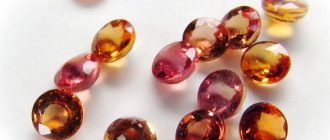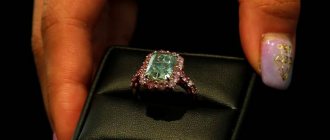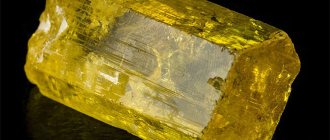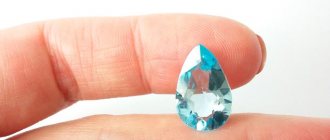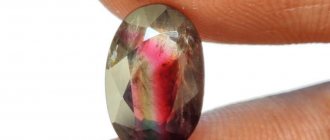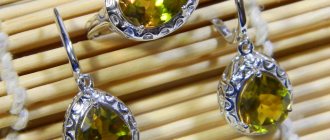When we mention gold, we imagine a precious metal that is used to make elegant jewelry, decorative items, and cutlery. It is believed that gold is something aristocratic, sparkling and expensive.
Confectionery art also did not stand aside; here the aesthetic side plays an important role - it also uses gold as a decoration for the culinary masterpieces of masters.
What is edible gold
Edible gold leaf is a very thin sheet that looks like foil.
It has neither taste nor smell, consists of 90% yellow metal, and natural silver is added to its composition to stabilize it. The supplement is absolutely safe to eat
and is used for the design of confectionery and other products as a decorative element. It is hypoallergenic and does not have any effect on the aroma and taste of the dish itself. According to European certificates, edible gold has its own unique number – E174.
Its manufacturing process is quite labor-intensive, and if you also take into account the cost of raw materials, then the rather high price of edible gold is quite understandable
.
As a result of production, absolutely smooth thin sheets are obtained, without cracks or creases. They are cut to size, lined with parchment paper and placed in packages. Residues and waste also find their use, and simpler jewelry options are made from them. They are available in the form:
- flakes, both large and small sizes
. The former can be used to create voluminous decorations for culinary products, the latter - as sprinkles; - powder
; - miniature objects
, for example, gold bullets, nuggets, ingots; - themed decorations
with inscriptions, hearts, Christmas trees, bells, etc.
With their help, confectionery products take on, one might say, a unique, expensive, elegant look.
This is especially true for exquisite celebrations - dishes decorated with gold will emphasize the special status of the event. The cost of such decoration can hardly be defined as budgetary, but the effect and impression made are worth it. Guests will definitely remember such original treats
. No analogues reminiscent of gold color can compare with the brilliance and beauty of real metal.
No special storage conditions are provided - the product does not deteriorate, does not break in the packaging, does not become moldy or get wet. You can store it for a year, but you need to treat it carefully and with care.
TYPES AND FORMS OF EDIBLE NOBLE METALS, INCLUDING VARK
There are two main forms of edible precious metals - gold and silver. Vark (or warak) is a name associated with the silver form. It is predominantly used in South Asian cooking for decorative purposes, especially in Indian sweets, dry fruits and nuts.
Both silver (vark) and gold come in several food forms.
- Sheets:
single or transfer sheets. The loose leaf is best used for decoration in small pieces. Due to its delicate nature, it requires extreme care when handling (for example, using special tools). Conversely, the transfer sheet is much larger, so it can be used to cover a larger area, such as an entire pie. It is a little more durable, so it can be carried directly by hand.
Edible gold sheets
- Cereals: There are several different varieties in this category:
- Dust: A very fine powder that when scattered gives a wonderful effect on confectionery, cocktails, desserts, etc.
- Flakes: Slightly larger than powder granules and free-form.
- Petals: Comparable in size to flakes, again randomly shaped, but due to their size they can be placed with tweezers.
- Figures: the largest in size, cut out in a specific shape, for example, in the shape of a heart.
History of appearance
Edible gold leaf has been widely used as an additive in dishes and decorations since around 2009.
However, the tradition of using metal in food dates back to the Middle Ages, when alchemists in Arab countries and China conducted their experiments. Later, Europe adopted their experience, the first drinks with precious metal appeared - this was a real luxury and a sign of special status; not everyone could afford to “eat and drink” gold
.
Today, the gold additive in dishes is used quite widely, oddly enough, but India has been the leader in this regard for a long time. Perhaps this fact also depends on local traditions - Indians often eat gold a lot, this is due to the belief in its unique qualities and its ability to benefit the entire body.
Can it be used in the food industry?
The food additive E175 (dye) is used extremely rarely, and if it is used, it is in very small quantities, since it is very expensive. We can conclude that if you follow all the recommendations when using the dye in the food industry, then it is considered absolutely safe for human health. Its use is permitted in the food industry in countries such as Russia, Ukraine and many others.
I wonder what gold tastes like? When creating large quantities of culinary gold, specialists spend more than eight hours, and the end result is that all the taste and aroma of such a precious additive are lost.
It is worth noting that only talented chefs use this dye. It can be granular, powdery, or even in the form of a solution. More often, of course, cooks use powder - it’s more convenient to work with.
Basically, in order to extract the precious dye, cooks use sheets of 24-karat yellow metal.
More often, the additive can be seen in expensive champagne and all kinds of desserts that are decorated with shiny shavings. Such culinary works can only be found in expensive elite restaurants. The price, accordingly, is also considerable.
It is worth noting that colloidal gold has a beneficial effect on the human body.
Medieval European healers treated many different diseases with the valuable metal. The first to discover the healing properties were alchemists from China and Arab countries. Product Description
| Name | Gold |
| Type | Additive for the food industry |
| Category | Food coloring |
| Description | An element with the index E100 – E199. Gives food an exquisite color and returns heat-treated products to their original shade. Can be natural or chemical |
How it can be used
Until recently, culinary jewelry made of gold was available exclusively in elite and very expensive establishments.
They were used to decorate cakes, pastries, and various desserts. But the use of the precious metal is not limited to this. For example, in France, gold dye is added to champagne - this makes the taste and appearance of the drink even more noble.
. Some candy manufacturers make edible packaging from edible gold leaf. In expensive establishments in Japan, it is added to sake, and sheets of it are placed in sushi.
Thus, confectionery is not the only area of application for gold jewelry
. In cooking, it is used as an original seasoning, giving a unique bright accent to the dish. It is also added as decor for exclusive food serving.
Gold was also used in coffee shops. With its help, you can make a real work of art from one small cup of hot drink.
The additive would be used much more widely, but so far the cost is an obstacle; it is so high that its use for mass production of confectionery products is unprofitable. And this is perhaps the only limitation.
Golden pizza will help improve your health
A Swedish chef named Ismail Ertekin is convinced that eating a small amount of such a noble metal as gold has a beneficial effect on health. In particular, it improves immunity. But simply eating gold in its pure form is not very pleasant. Another thing is to combine its intake with eating your favorite food, for example, pizza, which almost everyone loves. This is the kind of precious pizza that is served at the Avanti restaurant, where Ismail works. This establishment is located in Zurich, and, thanks to the inclusion of golden pizza in the menu, has already become quite popular.
It was once believed that wearing jewelry was good for your health. For example, original gold earrings can supposedly cure diathesis. And here is a new trend - golden food, which is decorated with a special precious, but at the same time edible, coating. Moreover, in the case of pizza, any type of this dish can be decorated with gold. All you have to do is express your wishes to the waiter, and the pizza you like will turn golden.
Among other things, according to the chef who creates golden food, it has a positive effect on mood. Thanks to its round shape and gold plating, the pizza looks like the sun, and will be especially appropriate on a sad, cloudy day. By the way, one serving of sun food has a fairly affordable price - it costs nineteen and a half Swiss francs (or 19.8 US dollars). I must say that this is much cheaper than boosting immunity with earrings or a ring. But it is important not to overdo it with gold intake - to boost immunity, the amount of the noble metal should be small.
About benefits and harms
It is believed that gold should be consumed to cleanse the body, for problems with the gastrointestinal tract and heart.
Of course, such treatment is practically inaccessible to the average person, but from this we can conclude that the metal does not cause any harm to the body. Gold is not absorbed into the blood, does not dissolve, is not retained and does not accumulate in the body.
. Takes part in strengthening the immune system and can even have an effect on enhancing brain activity.
Even in ancient times, gold was prescribed for the prevention and treatment of heart attacks, and currently numerous studies are being conducted in this direction, based on the results of which it can be said that indeed, in certain doses, the metal has a positive effect on the functioning of the cardiovascular, nervous and respiratory systems. Gold ions help the body slow down the aging process and remove toxins. Of course, such an effect is not guaranteed after eating one cake decorated with a golden curl, but nevertheless, the benefits of gold are obvious.
How did gold become edible?
- It turns out that gold is widely used in the confectionery, culinary and wine industries.
- For example, in France it is added to the best varieties of champagne, thereby emphasizing the noble origin of the wine brand.
- The Japanese also add gold to their national drink, sake.
- In England they sell golden confetti, which you should pour into a glass of champagne and drink the wine along with the confetti. There, the pies are wrapped in the thinnest gold edible film to give them a “solid” appearance.
- In some countries, edible gold foil is used for candy wrappers. Such sweets are not unwrapped, but eaten along with the wrapper.
Edible gold is completely harmless to the human body, since it is an inert metal. Thin golden leaves, specks of dust in the form of sparkles, and powder in the food industry are classified as additives by the standard and are designated E-175. But in the old days, doctors “prescribed” a solution of gold to treat certain diseases. For example, to treat heart attacks.
Photo: Source
Nowadays, information has appeared that taking gold is useful for nervous diseases and abnormalities in the respiratory system. Gold ions also normalize hormonal levels. We are talking about colloidal gold, used in medicine in ultra-small quantities. But let's return to our topic - edible gold.
As a product (yes, a product!) gold has hypoallergenic properties. This means that the content of harmful substances is minimal for those suffering from various forms of allergies. Gold also has bactericidal properties and improves immunity. At one time, the Japanese caused a real sensation by offering edible gold records for internal refreshment of the body. And the Swiss one advertised chocolate with edible gold flakes that restore brain function.
Edible gold in and on food products can be seen in stores in a number of countries - France, Spain, Italy, Great Britain, China, USA... But the largest consumer of edible gold is India. In this country, about twelve tons of it are eaten annually along with food!
24 Carrot Cake - carrot cake decorated with fondant and covered with thin leaves of edible gold Photo: Source
In other countries, eating gold is associated not with the body’s needs for it, but with traditions.
- So in Japan, gold is added to sake taking into account the popular belief that during the New Year celebration, drinking alcohol with gold will bring good luck.
- A similar sign exists in European countries with the addition of edible gold to wine drinks.
- And a gift of chocolates wrapped in edible gold foil is considered a very good gesture.
I wonder who can afford such gifts? Oddly enough, many. The peculiarity is that gold in the form of plates, wrappers, sparkles, flakes, especially for the food industry, is “packaged” in extremely small doses by weight and “dispensed” in the form of the thinnest films, from which you can cut anything. If you take such a food-grade gold plate, throw it into the air and blow, it will fall for half a minute, all the time turning over from one side to the other.
By the way, gold has neither smell nor taste. But the finest powder from this precious metal easily gives dishes the appearance of extraordinary luxury on the table. And this is another point why edible gold is in demand.
How much will it cost to feel like a very rich person? Let's say a Spanish company sells special edible gold dispensers for 50 euros. Then do the math for yourself.
Tags: gold, eating


